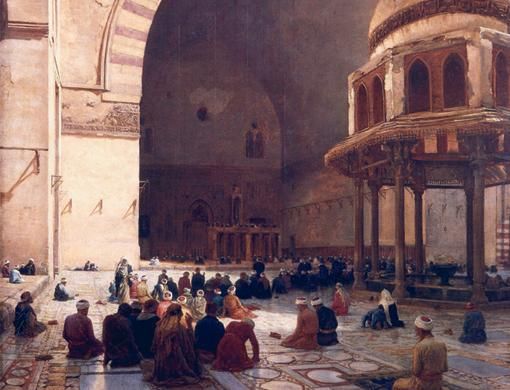Comprising 85 masterpieces from private collections and museums around the world, Lure of the East: British Orientalist Painting 1830-1925 is the first show of its kind in the region in terms of scope and scale.
The Sharjah Art Museum is the last stop for the The Lure of the East, which opened at the Yale Centre for British Art in the United States in February 2008.
It moved to the Tate Britain last June and to the Pera Museum in Istanbul in October.
Curated by Nicholas Tromans and Christine Reading, the show explores “the great range of artistic responses to the peoples, cities and landscapes of the regions lying just across the Mediterranean from Europe''.
It is organised along the themes of portraits, genre, landscapes, religion and home.
The works, by William Holman Hunt, Richard Dadd, Lord Leighton, John Frederick Lewis and David Roberts, among others, can be enjoyed at various levels — historical, political, sociological or on sheer artistic merit.
This kind of exploration was made possible as developed means of transport such as steamboat and rail became available to artists.
Travelling via Spain and Morocco, or through Greece and the Balkans, they visited Egypt, Palestine and Turkey.
While adventure must have been foremost on the minds of most of these artists, the rewards were many in terms of monetary and social interaction when they returned to Britain with folios rich in novel images. The artists braved the perils and strain of travel and weather.
Some such as Dadd, Hunt, Roberts and Edward Lear have provided interesting written records of their experiences, but most of the displayed works do not directly comment on the artists' cross-cultural dilemmas.
As they came across landscapes and monuments that defied imagination, the artists had to make a leap of vision to create these timeless works.
Even though some stuck to depiction of religious and historical subjects, the facets of culture unfolding before them inevitably seeped into the paintings.
Immersing themselves in the landscapes and milieu, many of these Victorian painters, as part of tradition, themselves adopted a variety of local attire and posed in them to reinforce their reputations and roles as artist-travellers back home.
In one painting, Roberts, the artist, is portrayed in a flamboyant Arab dress.
The work by Robert Scott Lauder titled David Roberts Esq. in the Dress He Wore in Palestine, was exhibited at the Royal Academy in 1940 alongside the sitter's first Eastern-themed landscapes.
In another painting dated around 1625, Mary Wortley Montagu strikes a delicate but defiant pose.
One of the first British women to accompany their husbands on a diplomatic mission to Constantinople, Montagu advocated local customs and popularised Ottoman-style dress.
The portraits of Lord Byron, Lawrence of Arabia, Mohammad Ali (pasha of Egypt) and Richard Francis Burton provide vignettes of these personalities from interesting phases in their lives.
In an unusual double portrait, James Silk Buckingham and his wife Elizabeth are shown in an Arab-style dress, representing a penchant for masquerades and portraits in costumes among the European elite of the time. It could also point to his ideological affinity towards the East.
The works in the section on gender and genre offer social commentary along with glimpses of everyday life or even history in the making.
William Allan's use of history and a tragic plot to illustrate The Slave Market, Constantinople (1838) is dramatic.
William Holman Hunt gives us a glimpse of the whimsical and personal in A Street Scene in Cairo: The Lantern Maker's Courtship (1854-1857; 1860-1861). The Westerner in the backdrop is a footnote to the playful mood.
Scottish watercolour specialist Arthur Melville's Cock Fight (1900), based on his visit to Muscat in 1882, is an experiment in style.
The artist has left a void at the centre of the action by washing out the fight itself, leaving the crowd “as a circle of focused attention''.
Panoramic views and a poetic mix of nature and architecture characterise Orientalist landscapes.
David Roberts's magnificent canvases focusing on the temple complex of Karnak along the Nile and the ancient world of Baalbek in Lebanon combine imposing structures and drama.
As opposed to the classical, George Price Boyce's The Pyramids (1861), William Blake Richmond's The Libyan Desert, Sunset (1888), Edward Lear's Petra (1859) and Beirut (1860-61), Thomas Seddon's View of the Nile near Cairo (1853-54) and John Lavery's Tangier: The White City (1893) are personal and modern, some of them exploring the tints provided by dawn and dusk.
John Frederick Lewis ventures outside Cairo to show us the temple in Edfou, Upper Egypt (1860).
Richard Carline's Damascus and the Lebanon Mountain from 10,000 Feet (1920), facilitated by military aerial survey techniques, provides a “privileged view'' of the landscape.
The works in the religion section affirm an admiration for Islamic culture without shying away from the complex religious dynamic of the time.
Monuments, prayers and the pilgrimage to Makkah are the subjects of the paintings, which eschew drama to give way to the grandeur of the structures combined with quiet contemplation.
The works depicting interiors and domestic life are fascinating and highly detailed, with façades, balconies and latticework screens providing the backdrop for most of the paintings.
Although the artists were barred from the female quarters, it did not prevent them from depicting domestic life.
But the arrival of women travellers changed the perspective of the harem as a purely domestic space.
The use of flower motifs in Henry William Pickersgill's The Oriental Love Letter (1824), Frank Dicksee's use of an epic character in Leila (1892) and the unusual composition of John Frederick Lewis's Hhareem Life, Constantinople (1857) are some of the most original approaches to this theme.
While Lure of the East: British Orientalist Painting 1830-1925 throws light on a particular period in history, it also leads us inevitably to confront the present and ponder on the constant historical and political flux that has characterised this region.












